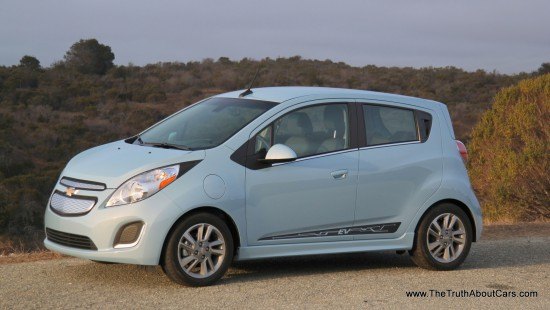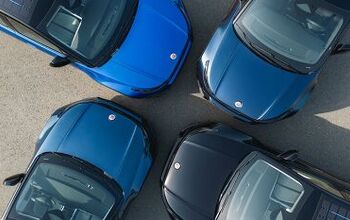GM Moves EV Pack Production In-House, Almost Had A Commodore EV
Automotive News reports General Motors will bring production of the Chevrolet Spark EV’s battery pack in-house to its Brownstown Township plant in the Detroit metro area, having already moved the subcompact’s 85-kilowatt electric motors to White Marsh, Md. in 2013. The pack was originally assembled by A123 Systems before Wanxiang Group picked up the torch. No new jobs will be created as a result of the move, spokesman Dave Darovitz stating GM would add jobs “if consumer demand requires it.” The packs for the 2015 Spark EV — whose market will expand to include California and Oregon later this year — will be 86 pounds lighter than the outgoing units, and will have a storage capacity of 19 kilowatts held within 192 lithium ion cells.
Speaking of GM EVs, GoAuto reports the Holden Commodore almost had an EV variant that would have been priced for $10,000 AUD ($9,400 USD) less than the Volt. Only seven pre-production units made it out of the joint venture between Axiflux, EV Engineering, Bosch Australia, Better Place, GE Finance and Air International before Holden announced it would end all local production by 2017. The announcement, along with the collapse and withdrawals among a majority of the project’s partners, led to Axiflux acquiring EV Engineering’s assets. The company plans to focus on industrial applications for the developed technology until the right partner comes along to pick up where the project left off for an automotive joint venture.
The Detroit Press says GM’s board of directors has retained New York-based Wachtell, Lipton, Rosen & Katz to give an “independent assessment” of the automaker’s inner workings. An unnamed source familiar with the announcement says the decision “was a good governance practice” aimed to deliver sound advice to GM’s senior management. The firm is the latest third-party to join GM’s cadre of attorneys, including Anton Valukas and Ken Feinberg, as the automaker navigates the legal waters in the wake of the February 2014 ignition switch recall.
Finally, Just-Auto reports GM is planning to expand its Indian operations into a global base of operations for small-car exports to Latin America and beyond. The exports will begin with 2,000 to 2,500 Beats to Chile in October from the automaker’s factory in Talegon, with some 30,000 to 33,000 units to leave annually for Latin America within two years. GM expects Mexico to receive the biggest imports from India, with over 12,000 units shipped annually.
Seattle-based writer, blogger, and photographer for many a publication. Born in Louisville. Raised in Kansas. Where I lay my head is home.
More by Cameron Aubernon
Latest Car Reviews
Read moreLatest Product Reviews
Read moreRecent Comments
- Theflyersfan With sedans, especially, I wonder how many of those sales are to rental fleets. With the exception of the Civic and Accord, there are still rows of sedans mixed in with the RAV4s at every airport rental lot. I doubt the breakdown in sales is publicly published, so who knows... GM isn't out of the sedan business - Cadillac exists and I can't believe I'm typing this but they are actually decent - and I think they are making a huge mistake, especially if there's an extended oil price hike (cough...Iran...cough) and people want smaller and hybrids. But if one is only tied to the quarterly shareholder reports and not trends and the big picture, bad decisions like this get made.
- Wjtinfwb Not proud of what Stellantis is rolling out?
- Wjtinfwb Absolutely. But not incredibly high-tech, AWD, mega performance sedans with amazing styling and outrageous price tags. GM needs a new Impala and LeSabre. 6 passenger, comfortable, conservative, dead nuts reliable and inexpensive enough for a family guy making 70k a year or less to be able to afford. Ford should bring back the Fusion, modernized, maybe a bit bigger and give us that Hybrid option again. An updated Taurus, harkening back to the Gen 1 and updated version that easily hold 6, offer a huge trunk, elevated handling and ride and modest power that offers great fuel economy. Like the GM have a version that a working mom can afford. The last decade car makers have focused on building cars that American's want, but eliminated what they need. When a Ford Escape of Chevy Blazer can be optioned up to 50k, you've lost the plot.
- Willie If both nations were actually free market economies I would be totally opposed. The US is closer to being one, but China does a lot to prop up the sectors they want to dominate allowing them to sell WAY below cost, functionally dumping their goods in our market to destroy competition. I have seen this in my area recently with shrimp farmed by Chinese comglomerates being sold super cheap to push local producers (who have to live at US prices and obey US laws) out of business.China also has VERY lax safety and environmental laws which reduce costs greatly. It isn't an equal playing field, they don't play fair.
- Willie ~300,000 Camrys and ~200,000 Accords say there is still a market. My wife has a Camry and we have no desire for a payment on something that has worse fuel economy.


































Comments
Join the conversation
Well, I'll tell ya. The monthly fuel cost on my Fit EV is less than $20, thanks to charging at night. It's no sports car, but has good torque and is comfortable for commuting (80 or 90 miles a day max). With the Tacoma for road trips, it's a good situation. The Spark will provide a useful alternative.
Always happy to see my current car talked about, although I've got the 2014, and not the 2015 model. I live in sunny Los Angeles, and commute about 65 miles/day in my SparkEV. It's incredibly efficient, especially in the kind of stop-and-go conditions we see around here. I usually get well over 5 miles/kWh, so I get a realistic range of about 100 miles per charge. I also installed a 5.5kW solar panel grid on the roof of my house, so unlike the gentleman who has to pay $20/mo, I pay $0/mo to drive to and from work. Interestingly, the math actually supports this, since previously I was spending over $300/mo on gas just commuting, and now I'm down to $0. Plus, with the panels also reducing my $250/mo electricity bill (as an SCE ratepayer, I'm less than pleased with the price of their service, $.31/kWh at the highest tier) down to $0, this saves me about $6600/yr. So a payoff period of about 5 years for both the panels and the car. After that, the car pays me to drive it. So if it lasts for only 6.5 years, (15k miles/yr * 6.5 years = 100k miles), and the battery is warranted to last that long, for about 1.5 years, it'll pay me to drive it. Not sure I see the downside to this arrangement. -Natebrau